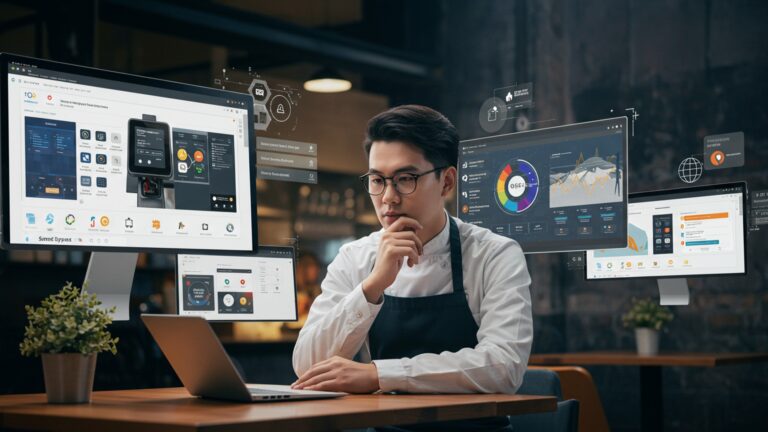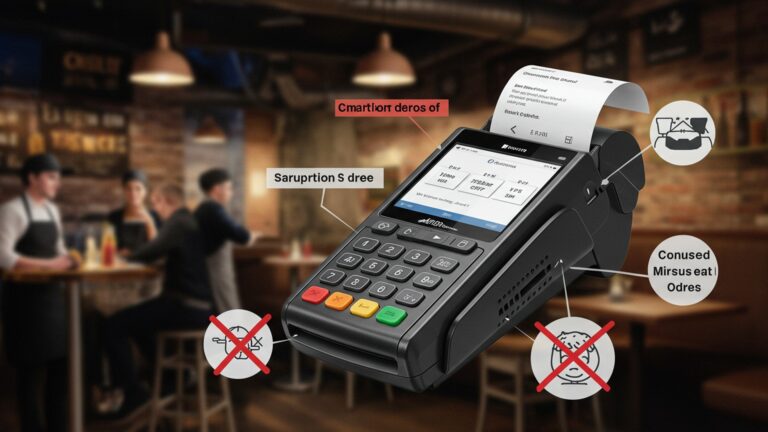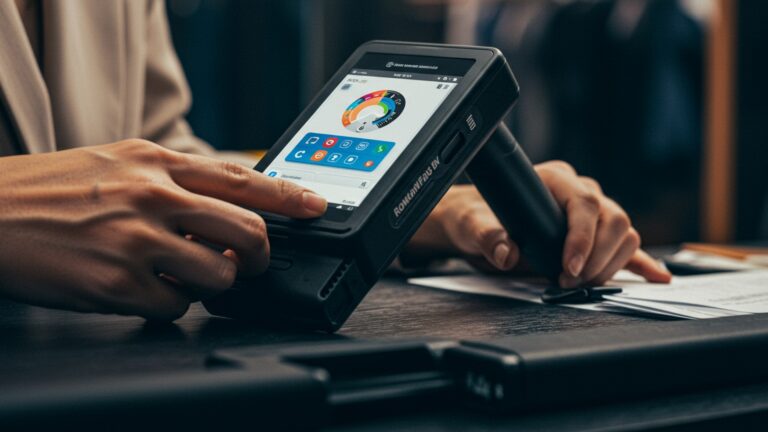Learn 6 Key Strategies to Streamline Service With Restaurant POS
In today’s fast-paced dining landscape, customers demand more than just great food; they expect impeccable service, speed. seamless interactions across every touchpoint. Meeting these heightened expectations requires more than manual effort; it necessitates an intelligent operational backbone. Modern Restaurant POS software has evolved far beyond basic transaction processing. Today, it acts as a central nervous system, integrating real-time inventory, streamlining order management from dine-in to delivery apps. facilitating diverse, secure payment options, including the rapidly adopted QR code and tap-to-pay methods. Leveraging its full potential is critical for transforming service bottlenecks into a competitive advantage and enhancing overall operational fluidity.

1. Centralized Order Management and Accuracy
One of the most immediate and impactful benefits of integrating a robust Restaurant POS software system is the centralization of all order management. In the fast-paced environment of a restaurant, errors in order taking, transmission, or fulfillment can significantly slow down service, lead to food waste. ultimately diminish customer satisfaction. A modern Restaurant POS software system acts as the digital hub for all transactions, ensuring accuracy from the moment an order is placed until it is delivered to the customer.
- Unified Ordering Channels: A comprehensive Restaurant POS software allows for seamless integration of orders from various sources. This includes dine-in orders taken by servers using handheld devices, online orders placed through your website or third-party delivery platforms. even phone orders. All these orders flow into a single system, eliminating the need for manual transcription and reducing the chances of miscommunication between front-of-house and kitchen staff.
- Real-time Kitchen Display Systems (KDS): Instead of paper tickets that can get lost or become illegible, a KDS connected to your Restaurant POS software displays orders digitally in the kitchen. This ensures that kitchen staff receive clear, prioritized orders instantly. It can also track preparation times, flag special requests (allergies, dietary restrictions). alert staff when an order is ready for pickup or delivery, streamlining the entire food preparation process. For example, during a busy dinner rush, a KDS ensures that appetizers for Table 7 are prepared before entrees. that the gluten-free request for Item B is clearly visible to the chef.
- Error Reduction and Efficiency: By digitizing the ordering process, the potential for human error is drastically cut. Servers can input orders directly at the table, with modifiers and special requests clearly logged. This not only speeds up service but also ensures that the kitchen prepares exactly what the customer ordered, reducing costly remakes and improving the overall customer experience. Consider a scenario where a server mishears a complex order; with a digital system, they can confirm choices on screen with the customer.
2. Optimized Inventory and Supply Chain Management
Effective inventory management is critical for a restaurant’s profitability and operational efficiency. Manual inventory tracking is time-consuming, prone to errors. often leads to either overstocking (resulting in waste) or understocking (leading to missed sales opportunities). Advanced Restaurant POS software provides powerful tools to automate and optimize this crucial aspect of your business.
- Real-time Inventory Tracking: Each sale processed through the Restaurant POS software automatically deducts the corresponding ingredients from your inventory counts. This provides an accurate, real-time snapshot of your stock levels for every item, from prime cuts of steak to a specific brand of olive oil. Knowing exactly what you have on hand prevents the frustration of running out of a popular dish mid-service.
- Automated Reordering and Vendor Management: Based on sales data and pre-set par levels, the Restaurant POS software can automatically generate purchase orders when stock runs low. Some systems can even send these orders directly to your suppliers. This automation reduces administrative burden, ensures you never run out of essential ingredients. helps you negotiate better deals by tracking vendor performance and pricing. For instance, if your POS detects that your avocado stock is below the reorder point, it can automatically draft an order to your produce supplier.
- Waste Reduction and Cost Control: By accurately tracking inventory and identifying popular vs. slow-moving items, you can make informed purchasing decisions. The Restaurant POS software helps pinpoint areas of waste, such as spoiled ingredients or over-portioned dishes, allowing you to implement corrective measures. This detailed insight into your ingredient usage translates directly into significant cost savings and improved profit margins.
| Feature | Manual Inventory Management | Restaurant POS Software Inventory |
|---|---|---|
| Tracking Method | Pen and paper, spreadsheets, periodic physical counts | Automated deduction per sale, real-time updates |
| Accuracy | Prone to human error, outdated data | High accuracy, up-to-the-minute data |
| Reordering | Manual checks, subjective decision-making | Automated based on sales and par levels |
| Waste Identification | Difficult, often discovered after the fact | Identifies trends, pinpoints sources of waste |
| Time & Labor | Very time-consuming, requires dedicated staff hours | Significantly reduced, frees up staff for other tasks |
3. Enhanced Customer Experience and Loyalty
In today’s competitive restaurant landscape, providing an exceptional customer experience is paramount. Restaurant POS software is not just a tool for processing transactions; it’s a powerful platform for understanding your customers, personalizing their experience. fostering loyalty.
- Personalized Service: A sophisticated Restaurant POS software system can store customer profiles, including their order history, dietary preferences. even special occasions. When a returning customer visits, servers can access this data, offering personalized recommendations or remembering their favorite dish. This level of attention makes customers feel valued and encourages repeat visits. Imagine a server greeting a regular by name and asking if they’d like “the usual” – this is achievable with good POS data.
- Integrated Loyalty Programs: Building customer loyalty is crucial for long-term success. Many Restaurant POS software solutions offer integrated loyalty programs, allowing customers to earn points, receive discounts, or get special offers based on their spending. These programs are easy to manage directly through the POS, providing immediate rewards and incentivizing customers to choose your restaurant over competitors.
- Faster and More Accurate Service: By streamlining order taking, kitchen communication. payment processing, Restaurant POS software significantly speeds up service. Shorter wait times for ordering, food delivery. checkout translate to a more pleasant dining experience. Customers appreciate efficiency, especially during peak hours. are more likely to return to a restaurant that respects their time.
- Flexible Payment Options: Modern Restaurant POS software supports a wide array of payment methods, including credit/debit cards, mobile payments (Apple Pay, Google Pay), gift cards. even split payments. Offering convenience and flexibility in payment options caters to diverse customer preferences and ensures a smooth, hassle-free checkout process.
4. Streamlined Staff Management and Efficiency
Managing a restaurant staff efficiently is a complex task involving scheduling, performance tracking. communication. Restaurant POS software can significantly simplify these processes, empowering your team and improving overall operational flow.
- Simplified Scheduling and Time Tracking: Many Restaurant POS software systems include integrated time clock functionalities. Employees can clock in and out directly through the POS terminal, accurately recording their work hours. Managers can then use this data to generate payroll reports and optimize staff scheduling, ensuring adequate coverage during peak hours while avoiding overstaffing during slower periods. This granular data helps managers create efficient rotas, reducing labor costs.
- Performance Monitoring and Training: The Restaurant POS software tracks individual server performance, including sales figures, average check size. upselling success rates. This data provides valuable insights for performance reviews, identifying top performers. pinpointing areas where staff might need additional training. For example, if a server consistently has lower average check sizes, it might indicate a need for training on suggestive selling techniques.
- Role-Based Access and Permissions: To maintain security and control, Restaurant POS software allows managers to set different access levels for various staff roles. For instance, servers might have access to order entry and payment processing, while only managers can perform voids, issue refunds, or access sensitive sales reports. This ensures that employees only have access to the functions relevant to their job, preventing unauthorized actions.
- Empowering Front-of-House Staff: Handheld POS devices allow servers to take orders tableside, send them directly to the kitchen. process payments without leaving the customer. This not only speeds up service but also allows servers to spend more time interacting with guests, improving the quality of service and potentially increasing tips. This efficiency can be a significant morale booster for staff.
5. Data-Driven Decision Making with Analytics
In the digital age, data is power. Restaurant POS software transforms raw transaction data into actionable insights, enabling restaurant owners and managers to make informed decisions that drive growth and profitability. This shift from gut feelings to data-backed strategies is a game-changer for modern restaurants.
- Comprehensive Sales Reporting: A key feature of advanced Restaurant POS software is its ability to generate detailed sales reports. These reports can break down sales by hour, day, week, month, or even specific menu items. You can identify your busiest periods, most profitable dishes. even compare performance across different locations or timeframes. For example, analyzing sales data might reveal that your brunch menu performs exceptionally well on Sundays, prompting you to allocate more staff or promotional efforts to that slot.
- Menu Engineering and Optimization: By tracking the sales performance of every item on your menu, Restaurant POS software allows for precise menu engineering. You can identify your “stars” (high popularity, high profit), “plows” (high popularity, low profit), “puzzles” (low popularity, high profit). “dogs” (low popularity, low profit). This data helps you optimize your menu by promoting profitable items, reformulating or removing underperforming ones. adjusting pricing strategies to maximize revenue.
- Labor Cost Analysis: Integrating time clock data with sales figures, the Restaurant POS software can provide detailed labor cost percentages. This allows you to see how much you’re spending on staff relative to your revenue at different times, helping you fine-tune staffing levels to achieve optimal efficiency without compromising service quality.
- Customer Behavior Insights: Beyond sales, some Restaurant POS software systems can track customer preferences, average spend. visit frequency, especially when integrated with loyalty programs. This data helps in developing targeted marketing campaigns, personalized promotions. understanding the demographics of your core customer base.
Understanding your business’s performance through these analytical tools provided by your Restaurant POS software allows for strategic adjustments in staffing, marketing. menu offerings, ultimately leading to a more efficient and profitable operation.
6. Seamless and Secure Payment Processing
The checkout experience is the final touchpoint for a customer. a smooth, secure payment process is crucial for leaving a positive lasting impression. Restaurant POS software is at the forefront of modern payment solutions, offering speed, flexibility. robust security.
- Multiple Payment Options: Modern Restaurant POS software supports virtually every payment method customers might use. This includes all major credit and debit cards (Visa, MasterCard, Amex, Discover), contactless payments (NFC like Apple Pay, Google Pay, Samsung Pay), digital wallets, gift cards. even split payments for groups. This flexibility caters to customer preferences and reduces friction at checkout.
- PCI Compliance and Security: Data security is paramount, especially when handling sensitive customer payment data. Reputable Restaurant POS software providers ensure their systems are PCI DSS (Payment Card Industry Data Security Standard) compliant, meaning they adhere to strict security standards for handling, processing. transmitting credit card data. This protects both your business and your customers from potential data breaches.
- Faster Transaction Times: Integrated payment processing within the Restaurant POS software means swifter transactions. Servers can process payments directly at the table using handheld devices, or at the counter, without needing to manually enter amounts into separate terminals. This speed reduces checkout lines and allows for quicker table turnover, especially beneficial during busy periods.
- Error Reduction in Billing: Manual entry of payment amounts is a common source of error. With an integrated Restaurant POS software, the exact bill amount is automatically transferred to the payment terminal, eliminating transcription errors and ensuring customers are charged correctly. This builds trust and avoids disputes.
- Simplified Reporting and Reconciliation: All payment data is automatically recorded and reconciled within the Restaurant POS software. This greatly simplifies end-of-day closing procedures, reduces accounting errors. provides clear reports for financial tracking and auditing. There’s no need to manually match receipts with transactions; the system handles it all.
Conclusion
Ultimately, embracing a modern restaurant POS is not merely an operational upgrade; it’s a strategic pivot towards unparalleled service efficiency and guest satisfaction. By leveraging the six key strategies we’ve discussed, you transform your POS from a simple transaction tool into a powerful engine for streamlining every aspect of your front-of-house operations, from faster order processing to seamless table management. Consider how a robust system effortlessly handles the surge of online orders and curbside pickups, a non-negotiable in today’s dining landscape, ensuring no guest feels neglected. My personal tip? Don’t just implement; integrate data analysis into your routine. I once saw a restaurant dramatically cut wait times by 20% during peak hours simply by adjusting staff roles based on POS-generated service flow reports. This proactive approach allows you to continuously refine processes, adapting to evolving customer demands and market trends. Therefore, let these strategies empower you to not just meet. exceed customer expectations, cultivating loyal patrons and securing a thriving future for your establishment.
More Articles
How to Master Restaurant Table Management With Your POS System
Learn 7 Smart Restaurant POS Features to Boost Your Business Profits
How to Streamline Restaurant Operations Using POS Software and a KDS Guide
Master 5 Smart Strategies to Boost Restaurant Efficiency Using Your POS
6 Common Restaurant Challenges Solved by Modern POS Systems
FAQs
What’s the main goal of using a restaurant POS to streamline service?
The primary aim is to make your restaurant operations smoother and faster, especially when serving customers. It leverages technology to manage orders, payments. communication more efficiently, reducing friction points in the service flow.
How does a restaurant POS system actually help speed up service in a busy place?
A good POS system streamlines service by enabling quick order entry, sending orders directly to the kitchen or bar, speeding up payment processing. improving table management. All these features work together to reduce wait times and boost staff efficiency.
Can you give an example of one of the ‘key strategies’ for streamlining service with a POS?
Absolutely! One key strategy is using mobile POS devices for servers. This allows them to take orders tableside, send them instantly to the kitchen. even process payments right there, significantly cutting down on trips to a stationary terminal and improving order accuracy and speed.
What common service problems can a restaurant POS help solve?
A POS can tackle a range of common issues like inaccurate orders, slow payment processing, miscommunication between the front-of-house and back-of-house, long wait times. difficulties tracking menu item availability, all of which often impact service quality.
Are these strategies difficult for restaurant staff to learn and implement?
While there’s always a learning curve with any new technology, modern POS systems are designed to be intuitive and user-friendly. With proper training and support, staff can quickly adapt to and master these strategies to enhance service efficiency and their own workflow.
What benefits do customers get when a restaurant uses a POS to streamline service?
Customers ultimately benefit from faster service, fewer order errors, quicker bill delivery and payment options. an overall more enjoyable dining experience. With smoother operations, staff can dedicate more time and attention to hospitality rather than administrative tasks.
Does a restaurant POS only help with taking orders, or does it do more for overall streamlining?
A restaurant POS goes far beyond just taking orders. It’s a comprehensive tool that streamlines many aspects, including inventory management, staff scheduling, customer relationship management, detailed sales reporting. even loyalty programs, all contributing to a more efficient and potentially more profitable operation.




